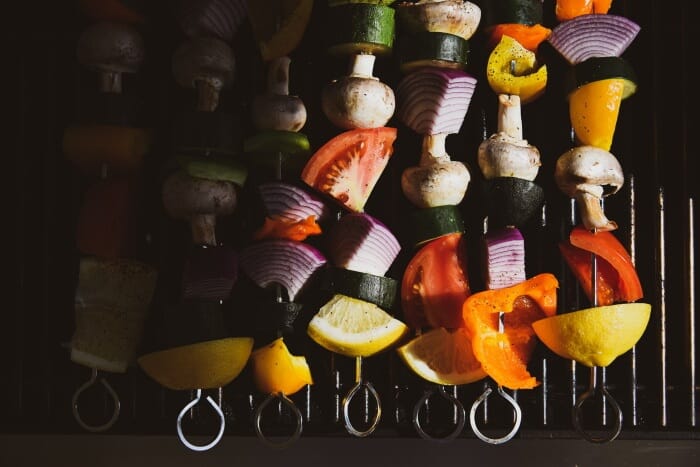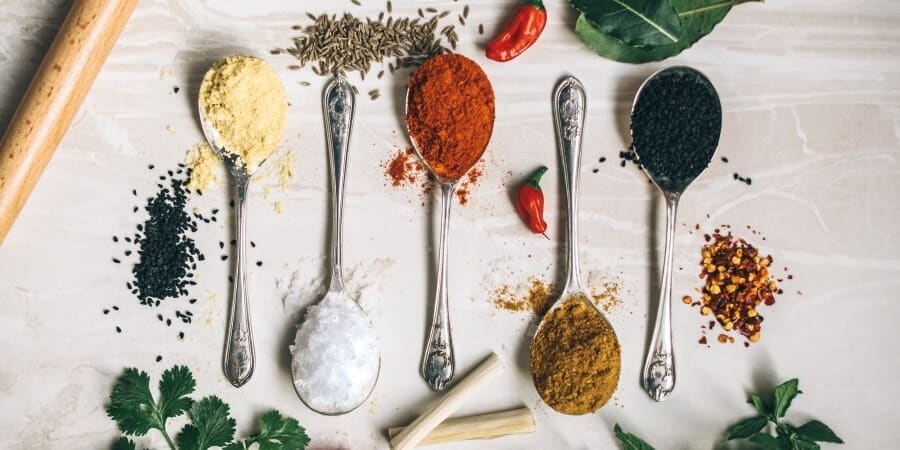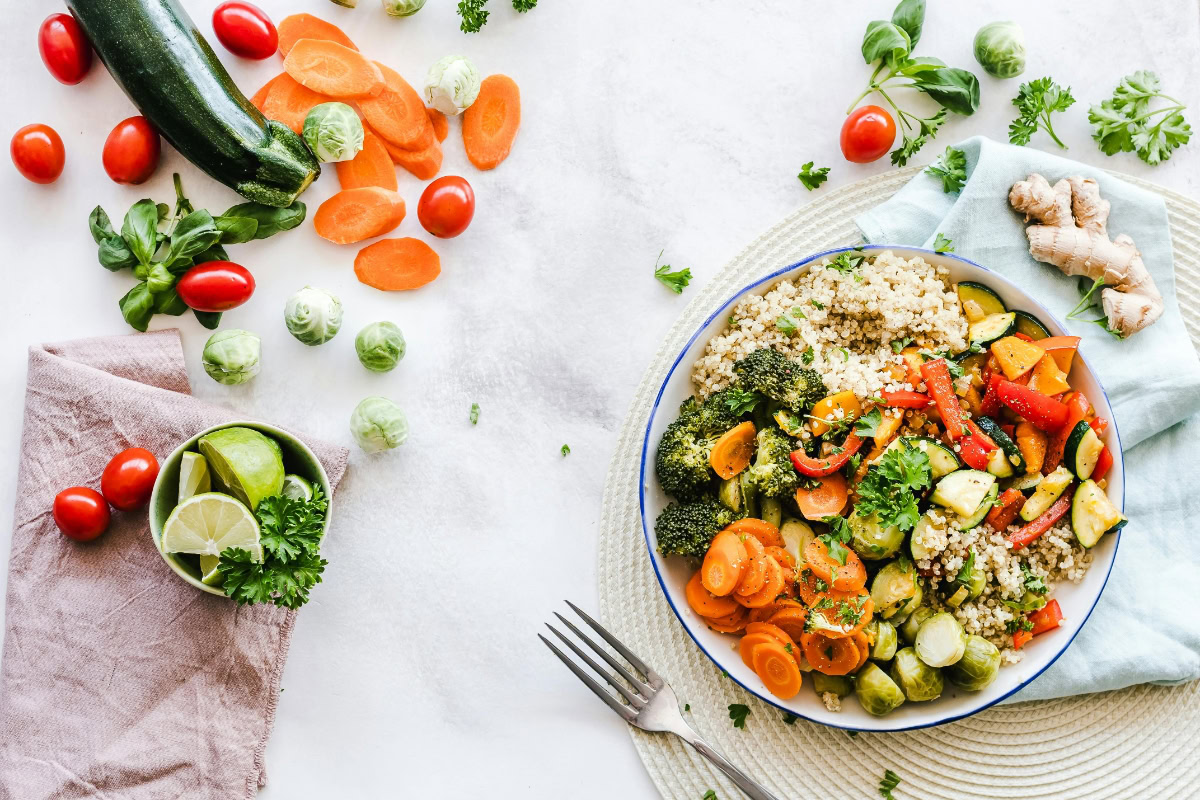If you were to take a survey about why people eat junk food instead of healthy food, the answer would be unanimous:
Fast food or unhealthy food items just taste better than their healthy counterparts.
The good news, though, is that these people are mistaken!
It isn’t that healthy food tastes bad or aren’t tasty – it is just that they are often prepared incorrectly! As a result, they end up bland and unappetizing.
If you are looking to turn your healthy diet into a flavorful extravaganza, here are the tips that you should use.
We are sharing with you 9 tips on how to make healthy food taste better!
1. Grill or Roast Vegetables & Choose Them Wisely

If your go-to method for cooking vegetables is boiling or steaming, then it is time to change things up. These cooking methods tend to zap the veggies of flavor and leave them soft and unappealing.
Instead, opt for sautéing, roasting, or grilling your vegetables.
Sautéing veggies involves cooking the ingredients on high heat with a little bit of oil and plenty of aromatics like garlic or onion. This maintains the crispness (and the nutrients) of the food while also adding serious flavor.
The great thing about roasting is that it allows the natural sugars in vegetables to blossom, making them taste sweeter. The best veggies for this cooking method are hardier ones:
- root vegetables
- potatoes
- Brussels sprouts
- cauliflower
- broccoli
Grilling, on the other hand, deepens the flavors of vegetables. Summer or winter, the following veggies will serve you well:
- bell peppers
- zucchini
- tomatoes
2. Marinate Your Foods
If you feel that various spices and herbs just sit on top of your foods rather than being absorbed by them, there is a trick that you can use:
Create a marinade with your herbs and spices and immerse your veggies or meats in it.
Soft veggies don’t have to be marinated for too long – around half an hour will do. Starchier or more fibrous vegetables can be marinated for an hour, perhaps longer. Meat often has to be marinated for several hours in the fridge.
Now, marinating your food can seem like a bit of a hassle since you have to start meal prep earlier. Once you give it a try, though, you will be able to appreciate how much more flavor this method adds to your meals.
3. Add Sautéed Aromatics
If you ever think that a dish could do with a little bit more flavor, consider adding sautéed aromatics to it.
Now, your top options are garlic, onion, shallots, scallions, and leeks. These ingredients don’t just smell pungent – they add amazing and complex flavors to food as well.
Heat a little bit of oil in your pan and cook these aromatics until they are transparent. Make sure not to overdo it, or you will end up with bitter flavors instead. Add the rest of the ingredients and then cook as instructed.
If you are trying to reduce the amount of salt added to the dish, add more aromatics than called for. The strong flavors will help to mask the lack of salt. And if you want to cook without oil, sauté the veggies in a little bit of water instead.
4. Season Your Food Liberally

If your healthy food tastes bland, then it just means that you aren’t using enough seasoning.
There are a lot of misconceptions regarding seasoning your food. Many people imagine that salt and pepper is the only way to go. And, since most people are trying to cut down on their salt consumption, salt isn’t added to dishes all that much.
In reality, though, there are so many different ways to healthily season your food.
Some awesome seasonings include:
- garlic powder
- onion powder
- smoked paprika
- cayenne pepper
- cinnamon
The list goes on!
In addition to there being plenty of seasoning options, you should also not hold back on the amounts. Go ahead and add as much as you need to make your dish taste good.
In case you don’t have the time or patience to measure and mix various spices, use a brand like Bearded Butchers Seasoning to enjoy pre-mixed flavors.
Best of all, there are so many different types of seasonings to choose from! So, it doesn’t matter if you are making Cajun food or barbecuing meat – there will be something for everyone.
5. Bolster Flavor with Acids
Ever wonder how professional chefs get their food to taste so good? Well, they know about a secret weapon – acids!
The most common acids include:
- lemon juice
- vinegar
- yogurt
- sour cream
- tomatoes
- and even wines!
Such ingredients help to brighten food, tenderize meat, and even allow flavors to seep into foods.
With meats, acids are especially useful during the marinating stage. So, add some yogurt or lemon juice to your marinades, and you will enjoy softer, more flavorful meat. A low-flavor vinegar can also do the trick.
If your salads feel like they are missing something, try a squirt of lemon juice or balsamic vinegar.
Need to brighten up bases like rice, quinoa, or couscous? Lime juice or lemon juice work wonders.
If one of your dishes appears to be falling flat, some lemon juice or a few drops of white vinegar can make all the difference, too.
6. Try Cooking With Flavor Infused Olive Oil

As you may or may not know, olive oil is one of the healthiest oils for you to use. So, if you want to fry, roast, or use oils for salad dressings and more, this is the oil to reach for.
If you are looking to punch up the flavor while reducing the need to use too much oil, your solution is herb or garlic-infused olive oil.
The best part is this is something you can make yourself! Here are the two top ways that you can make it:
Using a Mini Food Processor
Measure out about ½ cup of olive oil and several sprigs of your favorite herbs. You can also add roasted whole spices if you like. Place all the ingredients in your mini food processor and blend until it is completely mixed. Then, let it stand for an hour.
Pour the oil into a bottle through a sieve, separating it from the herb sediment. Then, top it up with about a cup and a half of olive oil. Replace the lid, and you can store it for up to two months.
Via Heat
Pour two cups of olive oil into a pan and heat – bring to a simmer. Add your chosen herbs and spices to the oil and steep for two minutes. Turn off the heat and let the herbs rest for up to two hours. Strain into a bottle and store for up to two weeks.
7. Improve Salads with Healthy Cheeses
Unless you are a diehard salad fan, salads can be a tough dish to incorporate into your daily diet. While proper seasoning and flavor-infused olive oil can go a long way in boosting flavor, you may feel like something is still missing.
If so, use healthy cheeses to kick things up a notch.
To minimize sodium, calories, and fat, stick to cheeses like:
- feta
- fresh mozzarella
- blue cheese
- ricotta
8. Add Creaminess with Pureed Cauliflower
If you are trying to add creaminess to pasta or other dishes, heavy cream can often seem like the only option. Of course, this ingredient is very good for you. Fortunately, pureed cauliflower makes an excellent substitute and adds lots of flavors too!
To prepare pureed cauliflower, cook cut up florets in water or vegetable stock. Once it is done, transfer to a blender. Add in vegetable stock, sautéed garlic, some salt, pepper, and plant-based milk. Blend until it forms a cream-like paste. Then, add this to the dish that needs a good cream base.
9. Don’t Forget About Texture
Believe it or not, texture can play an important role in how much pleasure you find in your meal. After all, imagine if you had to eat nothing but mushy peas or tough meat for the rest of your life – you would be pretty miserable, right?
To keep your meals interesting, make sure to play around with texture.
Adding a softer cheese to a crunchy salad can work wonders, for instance. Or, add some pomegranate seeds to your quinoa.
Want to add pizzazz to your greens? Toss in some toasted nuts – this will add both flavor and crunch. Not to mention, it will make the veggies more satisfying as well.
When putting together a dish, pay attention to what the overall texture will be. Then, find ways to switch it up. Once again, you will be surprised at how much of a difference this can make to your healthy dishes.
9 Ways to Make Healthy Food Taste Good, Wrapping it up
Eating healthy doesn’t mean it has to be tasteless. As you can see, there are plenty of ways to get creative with healthier ingredients. So, make sure to incorporate these tips and tricks in almost every meal that you prefer.
With time, you will find yourself automatically using these techniques in your food. Then, you will realize just how to make healthy food taste delicious without any effort!
For more cooking tips and recipes you should visit cookingdetective.com.
FAQ
How do you train your taste buds to like healthy food?
Training your taste buds to like healthy food can be done by gradually introducing new foods into your diet. Start by adding small amounts of healthy food to your regular meals, such as freshly cut fruits and vegetables, nuts, whole grains, and legumes. As you get used to these new flavors and textures, you can increase the amount of healthy food that you consume. Additionally, try to experiment with different cooking techniques, such as grilling or baking, rather than always relying on unhealthy fried foods. Finally, make sure to listen to your body’s signals – if certain foods don’t seem appealing after a few tries then it is best to move on and find other nutritious options that are more enjoyable for you. With time and patience, it is definitely possible to train your taste buds to appreciate healthier meals.
What can I add to food to make it taste better?
There are many different things you can add to food to make it taste better. Herbs and spices can be used to bring out the flavor of a dish, while sauces and condiments such as mustard, ketchup, and mayonnaise can add a kick of flavor or texture. You can also incorporate vegetables or fruits into your meals for added nutrition and flavor. For example, I usually add apples to a pork roast or mushrooms to a sauce can really elevate the taste of the dish. Another great way to enhance the flavor of food is by using stocks and broths as a base for soups and gravies. Finally, adding a bit of butter or extra-virgin olive oil can make all the difference when it comes to bringing out the natural flavors in any dish.
Can healthy food taste good too?
Yes, healthy food can taste good too! Eating healthy does not mean sacrificing flavor and enjoyment. In fact, many nutritious dishes are delicious and satisfying. For example, a spicy stir-fry of vegetables cooked in olive oil is both flavorful and healthy. Or try roasting root vegetables such as beets and sweet potatoes for an easy and delicious side dish. You can also make delicious smoothies with fruits like bananas and berries, or create your own unique salad with fresh greens and crunchy nuts. With a little creativity and experimentation, you can find plenty of tasty ways to enjoy healthy meals!




